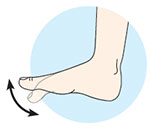Foot problems can worsen with diabetes. Learn how to prevent complications from the Podiatry Department at Singapore General Hospital.
Diabetes and foot problems
Additionally, foot problems can be complicated by diabetes, which itself is a common condition among the elderly.
Diabetics can suffer from poor blood circulation or neurological damage, and so may not feel pain from infections caused by abrasions or blisters. Their wounds also do not heal as quickly as non-diabetics.
That is why it is important for diabetics to check their feet every day for injuries and wounds, said podiatrists from the Podiatry Department,
Singapore General Hospital (SGH), a member of the
SingHealth group.
Tips to minimize foot problems
- Quit smoking. Exercise and maintain a healthy diet.
- Wear thick dry socks to absorb pressure on the feet. Cotton or wool is better than nylon. Avoid tight socks or stockings.
- Wear well-padded shoes with open toes or a deep toe box (the part of the shoe that surrounds the toes). If necessary, have the shoes stretched in the area where corns or calluses – an accumulation of dead skin layers – are likely to occur.
- Use doughnut-shaped pads over corns to lower pressure and friction.
- Apply petroleum jelly or lanolin hand cream to corns or calluses to soften them.
- Do not trim corns or calluses with a razor blade or other sharp tool to avoid accidental cuts and infection. Instead, soak in very warm water for five minutes or more to soften the hardened tissue before gently sanding it with a pumice stone. A pumice stone or fine foot file can also be used around the heels if the skin is thickened or dry.
- Wash feet daily. Dry them thoroughly and use a cream to prevent cracks that can lead to infections.
- Do not use cream on the area between the toes to avoid fungal growth. Use a soft bristle brush or toothbrush to clean the area between the toes.
- Do not delay seeking help for a foot problem. Early intervention is crucial for diabetics: about one in four diabetic patients will develop foot ulcers. Without treatment and if complications occur, amputation may be necessary.
Foot workout
Prolonged high blood glucose levels can lead to a narrowing and even blockage of blood vessels. In the feet, this can cause tissue damage, and complications that require amputation in more serious cases. Besides taking good care of the feet and following a healthy diet and lifestyle, regular exercise like walking can help to keep the blood flowing to the feet. Other simple exercises are:
- When sitting, move the ankles in a circular motion and wiggle the toes.

- Stand on the toes and lift the heel a few times every minute.
- Avoid putting the feet up when sitting. Gravity helps to get blood to the feet.
- Avoid crossing the legs when sitting as it can pinch off blood supply.
Page 1 - Foot care for the young and elderly
Ref: O17
